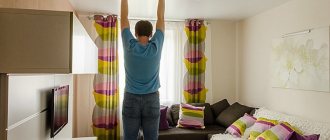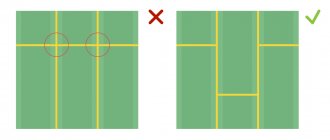What to do first - laminate, suspended ceiling or wallpaper.
Where should you start repairing? What to do first – walls, floor or suspended ceiling? You are also probably concerned about what materials should be chosen, in what sequence to carry out the work, and how to avoid mistakes. Such questions are the most common and frequently asked if you decide to renovate, including redoing the ceiling. You will find answers to all the questions listed above in the contents of the article. So, in repairs, the most important thing is a clear sequence of work, otherwise you will be guaranteed headaches and chaos. If you decide to install suspended ceilings, then it’s great and it’s worth it, but there are some points that you will have to take into account. The design of the suspended ceiling itself is not too complicated, and it can be done at any time. But if you are planning a partial or major renovation in a couple of years and replacing the flooring or wallpapering, then this will have an extremely negative impact on the new ceiling covering.
Color combination options
Successful play with color when arranging the interior is the most important task of the designer. Colors and their combinations become a means of expressing emotions and mood. The shade range reflects whether the interior belongs to a particular style or fashion trend. Also, different tones of decoration and furniture help to place the necessary accents or, on the contrary, “hide” the shortcomings of the room.
Color palettes for living room interiors
It has long been known that different colors are perceived differently by humans. They have a certain effect on his psyche: some calm him down, others irritate him. Therefore, you need to select shades for finishing materials and furnishings taking into account their effect on the body, and not just according to personal preferences. After renovation, the room should look harmonious and present a single artistic image.
Delicate tones
Pastel shades evoke thoughts of spring and the awakening of nature. These are muted halftones of different colors, as if faded under the rays of the sun. Pastel colors include any shade strongly diluted with white - light blue, light orange, light pink, etc. Pastel colors have a number of positive qualities:
- increase the level of illumination;
- visually expand the boundaries of space;
- give lightness, airiness, weightlessness;
- diversify the overall design.
Typically, pastel colors are not used in “strict” rooms, the interior of which should be brutal. But they are ideal for a girl’s room, bedroom, where a calming effect on the body is an important condition. In the living room you can also use this design option, but dilute it with bright details (green, blue, red). When decorating a pastel interior, you should follow the rules:
- use no more than three colors in one room;
- make the top of the room a couple of tones lighter than the bottom;
- choose darker flooring for practical purposes;
- introduce wood elements into the interior that go well with pastels;
- select furniture that matches the walls and floor well.
Pastel colors go well with natural wood
Contrasting colors
The contrasting interior design makes it catchy, memorable, and at the same time quite harmonious. Contrasting (complementary) colors in the color wheel are located far from each other, or opposite. Good examples are:
- orange and blue;
- red and green;
- purple and yellow.
It is not necessary to choose shades for the interior only based on “pairs” in the color wheel. Bright colors on any neutral background will be considered complimentary, because they will clearly stand out and become accentuated. The easiest way is to make the interior black and white. This option is ideal for many style trends. It is considered modern, trendy, and can easily tolerate dilution with richer tones.
The following design solutions look beautiful in the interior:
- dark wood floor, white ceiling, bright walls;
- white walls, dark flooring, furniture and accessories of any rich color;
- delicate light wall cladding, contrasting furniture, medium-toned floor.
Light colors
When decorating the interior, you need to strive to ensure that it is pleasing to the eye and does not look gloomy. With the help of light colors you can achieve a feeling of spaciousness and freedom, and this is the main advantage of this range. The maximum amount of white in the interior is now at the height of fashion. For example, in the Scandinavian or Provence style it often dominates, occupying the main share in decoration and furniture.
To prevent the room from looking sterile due to the abundance of white, it is worth using beautiful and harmonious color combinations. For example, in addition to white, other soft shades are used that will dilute the severity and coldness of the room. Another good option is to introduce embossed, textured materials into the design or use finishes with patterns, prints and designs. This will make even a monochrome white interior look original.
Apartment design in light colors
A room in which a significant part of the decoration is painted in soft colors will seem bright. This does not preclude the use of darker flooring or furniture. Against the background of white walls and a snow-white ceiling, gray, brown, blue furniture will not visually darken the space. It will only add a touch of individuality and emphasize the geometry of the room and its style.
Natural shades
Overload with computers, gadgets, poor ecology and other problems of the technogenic world force people to return to nature, including when decorating houses and apartments. Modern interior eco-styles have a beneficial effect on the body, allow you to relax and relieve daily stress. Natural colors are used for decoration, furniture, and design elements, recreating the desired effect.
A popular, but very expensive option is to cover the room with natural stone (marble, onyx) and wood. The use of high-quality solid wood furniture is no less in demand. The design will be complemented by living plants, flowers, phytowalls and phytopanels. It is less expensive to decorate a house with inexpensive materials in natural tones - brown, gray, sand, wood, dark green. Examples of room decoration are:
- dark wooden floor, caramel or sand walls, white ceiling, gray furniture (living room, office, dining room);
- dark wooden floor, stone or concrete walls, light ceiling, dark green or beige furniture (living room, hall, hallway).
Monochrome combinations and halftones
Monochrome design is an excellent solution for giving the room individuality and an unusual appearance. Monochrome does not imply the use of only one shade. Each color in the range has many variations, tones and halftones - for example, red has more than 50 of them. Usually a lighter shade is chosen as the base one, and bright details are placed against its background - household appliances, furniture, textiles, pillows.
Designers offer the following solutions for organizing a monochrome space:
- light floor, walls, ceiling, medium rich furniture, dark accents;
- dark walls, light floors, ceilings, accessories and furniture;
- application of a gradient - gradual darkening of the finish as it goes down from top to bottom.
Monochrome in the interior
Experts advise using chromatic halftones for classical design trends, and introducing achromatic tones into modern trends.
Cold and warm shades
The color palette includes warm and cold colors, which combine differently with each other and look different in decoration. The point is that some shades seem filled with sun, while others seem fresh and cool. Oddly enough, even a clearly cold tone can become warmer depending on the addition of other pigments.
To choose the right color scheme for a specific room, you need to focus on the location of the windows. When they go to the north side, the palette should be warm. It will improve your well-being and mood, set you up for positivity, and activate your brain. For southern rooms, a refreshing cold color scheme is suitable, which has the property of expanding space, calming, and optimizing attention. Designers also know how to combine cold and warm palettes, for example, introducing blue and sand colors into the design.
Coloristics is an interesting and comprehensively useful science. Knowledge of the basic rules and nuances of color is useful to everyone. With their help, you can independently furnish your home and achieve your desired design goals.
About technology
Let's start with a small lyrical digression from the directly posed question. To decide which comes first - wallpaper or suspended ceilings - it is advisable to clearly understand the technology for attaching the ceiling.
Let's look at the most popular solution - installing a PVC sheet with a harpoon.
- Along the perimeter of the room, the level of fastening of the baguette (mounting profile) is marked - a line strictly aligned along the horizon.
- Along the marked line in increments of 15-25 centimeters, mounting holes are drilled with a hammer drill.
Let us clarify: they are needed only in brick, stone and panel houses. Wooden walls allow you to secure the baguette with ordinary self-tapping screws.
- The baguette is secured with dowel screws.
- Then the canvas, pre-welded from strips of plasticized polyvinyl chloride according to the size of the room, is heated with a heat gun and stretched over the entire area of the ceiling; in this case, a specially shaped rigid edging of the canvas - a harpoon - is inserted into the groove of the baguette using a spatula and fixed in it with a simple latch.
- The baguette groove is closed with a decorative profile.
The photo shows the installation of decorative edging.
After cooling the polyvinyl chloride film, the ceiling acquires the necessary tension, leveling out the slightest folds on its surface.
Harpoonless fastening, usually used with fabric ceilings, differs only in the way the canvas is attached to the baguette. The basic sequence remains the same: marking - baguette - fastening the canvas.
How to combine the color of the ceiling, floor and walls
The color scheme of a room is very important when creating a comfortable space. And there are many clever tricks for breathing light and air into a small room, and making a spacious one with too high ceilings more comfortable and warmer.
Let's look at several options for color design of a living room that may be useful to many of you during your next renovation.
How to combine the color of the ceiling, floor and walls
Dismantling
Once you have everything planned, it's time to dismantle. If you started cosmetic finishing, then everything is simpler. They tore off the old wallpaper and put up new ones. But we are not here to discuss wallpaper. Our plans are more global, which means:
We dismantle old floors;
— remove the tiles that have lost their luster;
— we demolish unnecessary partitions;
— moving doorways to new places;
— we remove the painted baseboards to the side.
Now that you have gotten rid of everything unnecessary, you can move on to the next step of our plan “sequence in apartment renovation: floor, walls, ceiling.”
How to combine the color of the ceiling, floor and walls: bright walls, light ceiling, dark floor
A room that uses contrasting colors always looks stylish and catchy. In addition, by combining frankly light shades with richly dark tones, you can greatly correct shortcomings or emphasize the advantages of a room.
For rooms with low ceilings
Use a thick and dark shade for the walls, for example, in the form of wallpaper with a vertical ornament or pattern. You can do without a cornice or choose a thin ceiling cornice, no more than 5 cm wide to match the walls. The ceiling should remain light, and the floor, on the contrary, dark. Thanks to the even, rich color and verticals, the walls seem to “stretch out”, and the weightless ceiling against their background seems to float. The choice of a dark floor is not accidental, since it is it that creates the depth of space.
Repair process: what's what
The entire repair process can be divided into several stages:
Advice: if you do not plan to change the interior doors, it is still better to remove them from their hinges so that they do not interfere with the entry of building materials and removal of garbage, and also do not become dirty or scratched.
Current gradient: light ceiling, darker walls, dark floor
The living room, bedroom and any other room that uses different shades of the same color scheme looks harmonious and very traditional. If you are a fan of a measured lifestyle and you like the classics more than other styles, you can choose, for example, the color of dark chocolate for the floor, cocoa for the walls, and cream for the ceiling.
Stretching from dark to light brings harmony and peace. This combination is designed to balance and correctly distribute the load of all horizontal and vertical planes. To this it should be added that this combination of colors of walls, floors and ceilings is perfect for rooms of any type.
The selected range can be supplemented with white or dark brown and black on skirting boards, doors, trim and cornices, depending on the task. Colors and shades for furniture and accessories are chosen at your discretion, but based on the thermal saturation of the walls, floor and ceiling.
How to combine the color of the ceiling, floor and walls
Light and air: light ceiling, light walls, dark floor
If you have chosen dark parquet or laminate for a small room with low ceilings, there is no need to be afraid that the color of the floor will steal precious centimeters of height. We recommend that you correct the situation by simply using only light transparent shades for all walls and ceilings and curtains. Platbands, cornices and skirting boards should also be used in white or the most suitable light tone.
We do not recommend cluttering the already heavy-toned floor with a large amount of furniture with rich texture and color of the upholstery. Use only necessary items with laconic shapes and graceful lines. You can lay a light light rug on the floor, which will visually distract from the dark floor.
How to combine the color of the ceiling, floor and walls
Communications layout
Now you need to clearly think through what will be located where, and the main thing is not to forget anything! All necessary sockets, television, telephone, air conditioning, sound systems, internet. Also, don’t forget about heating, plumbing, and sewerage.
Important! Think carefully about all these points, because later it will be either very difficult or impossible to correct something.
Combination of colors in the interior. Everything is important: floor, ceiling, walls, furniture
In order to correctly select the color combination of walls, ceilings and floors, you must follow certain rules. Next, the secrets of the designers will be revealed and a table will be provided on the possibility of optically changing the internal volume using a play of colors.
To select the right color, you can use the color wheel
In order to correctly and beautifully combine shades in the interior, you should adhere to certain rules
- 1 Laws for choosing floor colors - a combination of house elements
- 2 Features of choosing flooring colors in the kitchen
- 3 Color combination of walls, floor and ceiling
- 4 Combination of floor and doors
- 5 How to visually change the volume using the floor?
- 6 Selection of carpet and wallpaper
- 7 Video: Combination of colors in the interior
- 8 50 photos of examples of the correct combination of colors in the interior: 8.1 See also
First sticking
Stages of work:
- First, you need to thoroughly clean up all construction debris and remnants of previous coatings.
- Let's evaluate the scope of work.
- If necessary, we waterproof the floor using bulk mixtures or mastics.
- We produce a rough screed using self-leveling floor technology, laying a cement mixture or adding expanded clay.
- We prime, carry out a finishing screed or lay special slabs or a dry floor.
- Self-leveling floors must be coated with a primer at each stage.
- We putty the walls with a rough layer to eliminate large-scale unevenness.
- After drying, sand and prime the surfaces.
- Finishing putty is a mandatory step. The wallpaper will stick better and stains and defects will not show through.
- Laminate flooring is laid.
- Install floor skirting boards between the wallpaper and the floor.
Laws for choosing floor colors - combination of house elements
The color of the floor in the interior plays a key role. Depending on the structure of the floor covering, its pattern and color, a further selection of colors is made for the finishing of walls and ceilings, as well as doors and furniture are selected.
There are 2 basic rules that must be followed.
- When purchasing flooring, baseboards, doors and furniture, you should use a maximum of 2 color schemes. To achieve a certain effect, you can use contrasting design. All interior elements should be in the same warm or cold palette.
- To avoid disharmony, when choosing wall colors, you must adhere to the trinity of shades. Namely, the surface coating should contain a maximum of 3 main colors.
To get a special effect, don’t be afraid of halftones. They contribute to the harmonious fusion of many different shades without harming the unity of style. Contrast is often used in modern design.
To get a special effect, don’t be afraid of halftones
To avoid disharmony when choosing wall colors, you must adhere to the trinity of shades
When purchasing flooring, baseboards, doors and furniture, you should use a maximum of 2 color schemes
Continuation of preparation: furniture is moved, unnecessary elements are dismantled
An ideal option if, in order to carry out renovations, it is possible to completely empty the apartment of furniture and interior elements. But, most likely, it will have to be moved to one of the rooms so that it does not interfere with work. We lay it compactly and wrap it with stretch film. Renovation begins with other rooms. When at least one room is ready, the furniture is moved there, arranging it as the rooms are ready.
The next step is to dismantle the elements that need to be replaced. If the repair is cosmetic, remove the layer of old linoleum and remove the wallpaper. During a major renovation, you may have to remove interior doors, remove partitions, change the location of doors, create special niches in the walls, remove plumbing, etc. If you are not going to change the floor, but only update it, do not forget to cover it with film so as not to damage it.
Time to remove the old windows if you are going to install new ones. After installing the windows, do not remove the protective film from them. Let it remain during the repair and protect the glass from scratches, dirt, and dust that are inevitable during repairs. If redevelopment is planned, there is a desire to start from scratch, we demolish non-load-bearing partitions.
Features of choosing flooring colors in the kitchen
As a rule, in the kitchen and in the corridors they try to lay moisture-resistant linoleum, glue porcelain tiles or lay moisture-resistant laminate. The variety of patterns allows you to vary when choosing the color of walls and furniture facades.
Usually, when arranging living rooms, the furnishings are chosen closer to the color of the doors. In the kitchen, horizontal surfaces should be in harmony with each other. In such a fusion of the floor pattern and furniture, the decoration of the room will be cozy and comfortable.
Bright colors of tiles can be:
- dilute with white tiles;
- apply various types of ornaments;
- Repeat the patterns laid out on the floor on the apron set.
It is very important that the color of the floor is in harmony with the furniture and walls
Usually tiles or linoleum are laid in the kitchen
In the kitchen, the color of the floor should be in harmony with other elements
The wide variety of linoleum produced increases the variations in the choice of facades and other elements of kitchen furniture.
More austere natural laminate coatings are usually used to create a classic style. The main thing when buying material is that the color of the floor and furniture match.
When decorating a small kitchen, you need to take into account that a diagonally laid pattern of tiles or linoleum visually expands the area.
You can see the selection of colors in the table below.
Color compatibility table
Color wheels for color selection
Surface preparation - cement works
All existing surfaces, namely the floor, ceiling, walls, must be leveled.
We start with plastering the ceiling, if necessary, then level the walls (we don’t cover it with plasterboard, but plaster it), and finally we come to the floor screed.
Important! If you planned to have heated floors in your apartment, then you need to lay them before the floor screed.
Color combination of walls, floor and ceiling
The apartment will become comfortable to live in if the color combination of the floor and walls in the interior is correctly selected.
Looking at the color chart, you will notice the following.
- The contrast of a dark floor, bright wallpaper and a white matte ceiling can significantly change the height of the room. Furniture in such rooms is installed in pastel shades, in small quantities, so as not to clutter the floor.
- Using the same color in different tones gives harmony and peace. Mostly cream colors are used. In the classic style, this is the most common palette. It applies to any type of housing.
- Having chosen the floor color mahogany, wenge or chocolate for a small room, the remaining surfaces should be done in a light, almost white color. Soft colors will optically push back the walls and raise the ceiling. Absolutely white matte painting will make the surrounding volume faceless. It will completely lose its shape.
- Opposite surfaces attract, giving different sensations. Such tinting can be suitable for any room, depending on what result you want to get in the end. For a high apartment, a dark floor is ideal, the ceiling and cream walls match it. Low rooms will be lifted by a white glossy ceiling and a light floor with rich side planes.
Screed
Layers of concrete floor are created in the following order:
- Underlying layer. Flooring on the ground begins with removing the top layer of soil and creating a layer of sand and crushed stone or concrete. The floor on top of the ceiling in the apartment is made without an underlying base.
Floor preparation
- Waterproofing. It is created from film, membrane, roofing felt. Concrete can be coated with bitumen mastic.
- Thermal insulation. For floors on the ground it is required. For floors on ceilings, insulation is laid only in unheated rooms or in rooms located above basements or arches. The heat-insulating layer is created from expanded clay, polystyrene foam, mineral wool, polyurethane foam or other insulation. The same material serves as sound insulation, which is necessary for flooring.
- Then a reinforcing mesh is laid. If a heated floor is provided, then the heating system pipes are attached to it.
The next stage is pouring the screed. It is performed as follows:
- To obtain a flat surface, beacons made of metal profiles or wooden blocks are installed. If the area is large, then formwork will be needed, since it will not be possible to pour concrete at one time.
Lighthouses
- Concrete is poured in a layer up to 8 cm thick with a shovel. Align it using the rule, moving it along the guides.
Alignment
- The formwork and beacons are removed after pouring is completed. The voids left behind are filled with concrete.
- The surface of the new floor is covered with film for several days.
Combination of floor and doors
An important role in the design is played by the color of the floor and the texture of the doors. It is a mistaken belief that they must be the same color. Depending on the design decision, these interior elements can be:
- in one color;
- in a contrasting solution;
- white or painted doors and any floors.
Made in contrast, the doors are framed with a platband matching the color of the floor, or skirting boards are used to match their texture. The furnishings and decoration in such rooms are selected to match the door panels. It fits perfectly into the overall layout.
The room can be done in one color scheme
Some elements can be highlighted in color
How to decide on a color?
There are many different theories about what colors should be used in which rooms. At the same time, it's up to you to decide which colors make you feel best.
For example, there are people who love their homes decorated in black, red and white. And some people view it negatively because it increases blood pressure and causes increased adrenaline.
The first question designers ask their clients is: “What is your favorite color?” And if family members cannot come to an agreement, the specialist tries to combine their favorite shades in one combination and find a compromise that suits the clients.
How do you know which color you like best? Just choose any image that will please the eye. Using special services such as Bighugelabs, you can determine the palette of each image and photo.
This way the program will mix the shades and give you an average of three to five tones. You will be able to see the accents in the original photo and use these colors in the interior.
If you don't find anything suitable, use the color wheel. Online services such as Colorscheme can help you find harmonious combinations of monochrome, contrast and accent palettes. You can change the brightness of the base tone, making it darker or lighter.
For example, if your base color is chocolate and you want to use 5 different colors, then 65% will take the base tone.
In our case, it would fall on the sofa, wardrobe and chair. Delicate turquoise on the walls will become her companion. And use orange pillows and curtains as an accent. At the same time, a delicate tape in the form of parquet will appear on the floor. And the icing on the cake will be mint or mustard green in the form of a discreet bouquet.
General recommendations
The following should be highlighted:
Don't rush - you can't fuss in big matters. Renovating an apartment is a great undertaking and should be approached thoughtfully.- When drawing up a project, you should take into account all dimensions, write them down correctly, and do not trust technical data sheets; it is better to check everything yourself.
- Inexpensive overhaul with your own hands is even possible, since it can be completed independently in about 3-3.5 months.
- You should consider whether it is worth contacting freelancers for the most important work, because they usually work without signing a contract, so if something happens, you will not even be able to make a claim.
- When making initial repairs in a new building, you should not buy expensive finishing materials. New buildings must wait until the shrinkage takes place. Usually the first repair is simple, for a maximum of a couple of years.
That's all! We hope that the article helped you and now you have enough knowledge to carry out the repairs yourself.
Style and color
Each style has its own palette, from which you cannot deviate. By introducing, for example, neon colors into a classic interior, we get kitsch on the verge of tastelessness.
Physiologically, a person evaluates the environment as safe and stable when the darkest shade is underfoot, mid-tones are at eye level, and sky-white shades extend above the head.
At the same time, modern interiors suggest that designers love to play and turn them upside down. That is why there are chocolate and even black stretch ceilings on beige and white floors.
So, here is a table of styles and colors.
| Color | Style | Combination with other colors. | Suitable for: | Characteristics |
| White | Modern, Classic, Art Nouveau | All of them | All rooms | Adds lightness and expands the room |
| Grey | Provence, Country, Classic | Yellow, green, red, orange, black, white, purple. | Office, hall, teenage room, kitchen. | Neutral color. Suitable for quiet times. |
| Black | Art deco, hi-tech, modern, loft, minimalism. | Purple, white, gold, red, orange. | Great salon | Visually reduces space and is associated with luxury. |
| Red | Modern, high-tech, minimalism, classic, art deco. | White, brown, purple, grey, orange, light grey. | Living room, kitchen | Activates the optic nerve |
| orange | Art Nouveau, Provence, Minimalism, Modernity. | Beige, black, white, blue, green, red | Living room, kitchen | Delicious, reminiscent of oranges. |
| Yellow | Modern, minimalist, Provençal. | White, grey, purple, brown, black, red, blue. | Spacious living room, children's room | It reminds you of summer, the sun and improves your mood. Often used as an accent. |
| Green | Classic, country, modern. | Beige, brown, white, gray, yellow. | Kitchen-living room, living room, children's room, kitchen, bathroom | Gives the interior freshness. |
| Pink | Art Nouveau, Classic, Shabi Chic, Country | Black, red, purple, white, gray. | Girl's room, living room, kitchen. | Pastel pink calms bright exhaust fumes |
| Blue | Classic, technological, country, loft. | White, green, red, grey, brown, yellow, black. | Large living room, children's room, kitchen, bathroom, toilet, studio apartment. | This adds solidity and calmness at the same time. Embodying originality and practicality. |
| Purple | High-tech, classic, loft. | White, pink, green, yellow, black, blue. | One-room apartment, bathroom Room, living room, kitchen, children's room, bedroom | Associated with lilac, spring tones |
| Brown | Modern, Country, Provencal, Classic. | White, red, green, grey, purple, yellow, black, orange, beige | Living room, kitchen, bedroom, corridor, bathroom, closet. | Creates a homely atmosphere, adds comfort and warmth. |
If you follow designers' guidelines and use color palettes that suit your own style, you will always benefit. Use the color wheel in situations when you are in doubt about choosing a particular interior element. It’s even better to entrust the creation of the project to the masters. In this case, your home will be decorated with taste and fully corresponds to the chosen style.
The procedure for performing repair work
Many companies, when performing repairs, adhere to a clear algorithm. This allows you to achieve high quality, which is clearly visible in the photo. Most often, the sequence of work is as follows:
- The preparatory stage is leveling and priming the walls.
- Installation of stretch ceiling.
- Installation of the cap and ceiling plinth.
- Wallpapering, trimming uneven edges.
There is one secret that will allow you to subsequently make cosmetic repairs without damaging the ceiling. Wallpaper should not be glued under the baseboard, but strictly close to it. In this case, you can remove the annoying coating without any problems.
The case when everything is done the other way around
However, it is not always necessary to make the ceiling first, and then the walls. For example, if you need to fix drywall. In this case, you should start with vertical surfaces, first installing a profile of the required overall dimensions on them.
Afterwards, the plasterboard slabs are attached, and only then it is recommended to begin facing work on the horizontal surface, that is, the ceiling. For installation, strong supporting structures are used that can easily withstand the heavy weight of plasterboard boards.
Main conclusions
So, as you can see, there are different options for installing facing materials. It all depends on what products are used in the repair. Of course, in most cases it is better to start at the top and move to the bottom - this is rational and justified. It also allows you to create really high-quality interior design, as you can see in the photo. And remember one more rule - it is important to use high-quality materials, then the results of the work will bring maximum satisfaction.
It is quite possible to repair the ceiling in an apartment yourself, and for this you do not need any special skills in construction and finishing work, but just follow the instructions. Almost every person has encountered problems such as uneven ceiling coverings, flooding, leaks and more. Naturally, you want to live in comfortable conditions and in a pleasant atmosphere, and therefore you have to think about carrying out repair and finishing work.
To repair the ceiling with your own hands, it is worth deciding what types of work exist and what features they have.
Works are divided into:
- Dry;
- Wet.
If there are minor defects on the ceiling, then major repairs are not needed and a dry renovation of the coating is sufficient. Naturally, a complete replacement of the ceiling covering will require not only investment, but also a lot of effort, patience and materials. Replacing the ceiling covering in a room is actually not difficult, but you will need to follow the instructions and completely follow each step.
Initially, the room should be cleared of anything that could be damaged during the renovation. Namely, from furniture, carpets and household appliances. The floor itself is covered with a special film so as not to damage the coating.
There are various ways to finish the ceiling surface that are worth exploring before purchasing materials:
- Coloring;
- Paneling;
- Leveling and applying decorative plaster;
- Installation of suspended and tension structures;
- Elimination of drips;
- Repairing after a leak from the roof or removing damp parts of the cladding.
Rules for choosing colors for floors, walls, furniture and ceilings
So, we figured out which color corresponds to which style. Next, we will look at the items that are present in each room and understand the rules for using certain shades.
There are a few unspoken rules to consider when choosing a floor color.
- Increases space.
- This is a reflective fabric.
- Can be used with walls of a lighter shade.
- Suitable for bedrooms, bathrooms, toilets, living rooms.
- It harmonizes with both light walls and the ceiling and dark walls. But it must be at least 1 ton darker.
- Suitable for any room.
- Its background looks good with bright accents in good lighting.
- Doesn't fit well with dark doors.
Walls
The walls can be made in any color. Depending on the purpose of the room used, it can be active, passive or neutral.
The accent is active colors. They are combined either with the opposite light color, or with a less light, calm color.
A popular solution is a wall in pastel colors. Take on the role of background to the main view of the room. In this case, you can use any floor, furniture, or ceiling. Because this is a universal option.
Ceiling
The ceiling is most often chosen in shades of white or light. Because it is a universal color and can be combined with any furniture, ceiling and floor. It can be matte or glossy. If you want to add contrasts, it is better to add rich colors to the walls or furnishings. It can be used in any room.
We act according to the scheme
The movement of finishing the apartment should be carried out from top to bottom: ceiling → walls → floor. This way you won’t have to worry that the part of the repair that has already been completed will be spoiled or damaged. However, there are some amendments to this course of events.
Floors. If you intend to make a new floor screed, then your path will begin from the floor, and not from the ceiling. There are two ways:
Leveling the floor using cement mixture
Fill a self-leveling self-leveling floor
The first option is cheap and labor-intensive, the second is more expensive and simpler. If possible, use the second one. You will not regret. The self-leveling floor will dry in a couple of weeks.
If the screed will not be made, follow the above scheme.
Walls. For leveling you will need plaster. The number of layers applied depends on how smooth the walls are. In turn, the time spent on leveling depends on the number of layers of plaster.
The second method is drywall. Installs easily and quickly. It is usually puttied in two layers. The first is the starting one, the second is the finishing one. It is easy to install communications and cut holes in plasterboard structures. For example, under sockets. In addition, such walls will be perfectly smooth. The only disadvantage of a plasterboard block is that it takes up part of the area.
Ceiling. The principle is the same here. Either you putty or use drywall for leveling. Pros of gypsum:
it is very easy to install lighting (spotlights, LEDs);
- the ability to make figured ceilings.
Another point that stands out from the basic scheme of “sequence in repairing floor, walls, ceiling” is a suspended ceiling. This part is best left for last. You can design boxes for suspended ceilings initially, during rough work. But you will mount it at the end.
Is the dirty work done? Start cleaning.
After installing the door frames, proceed to painting and pasting. When the cosmetics are ready, we finish by assembling the baseboards, sockets and other decor.











